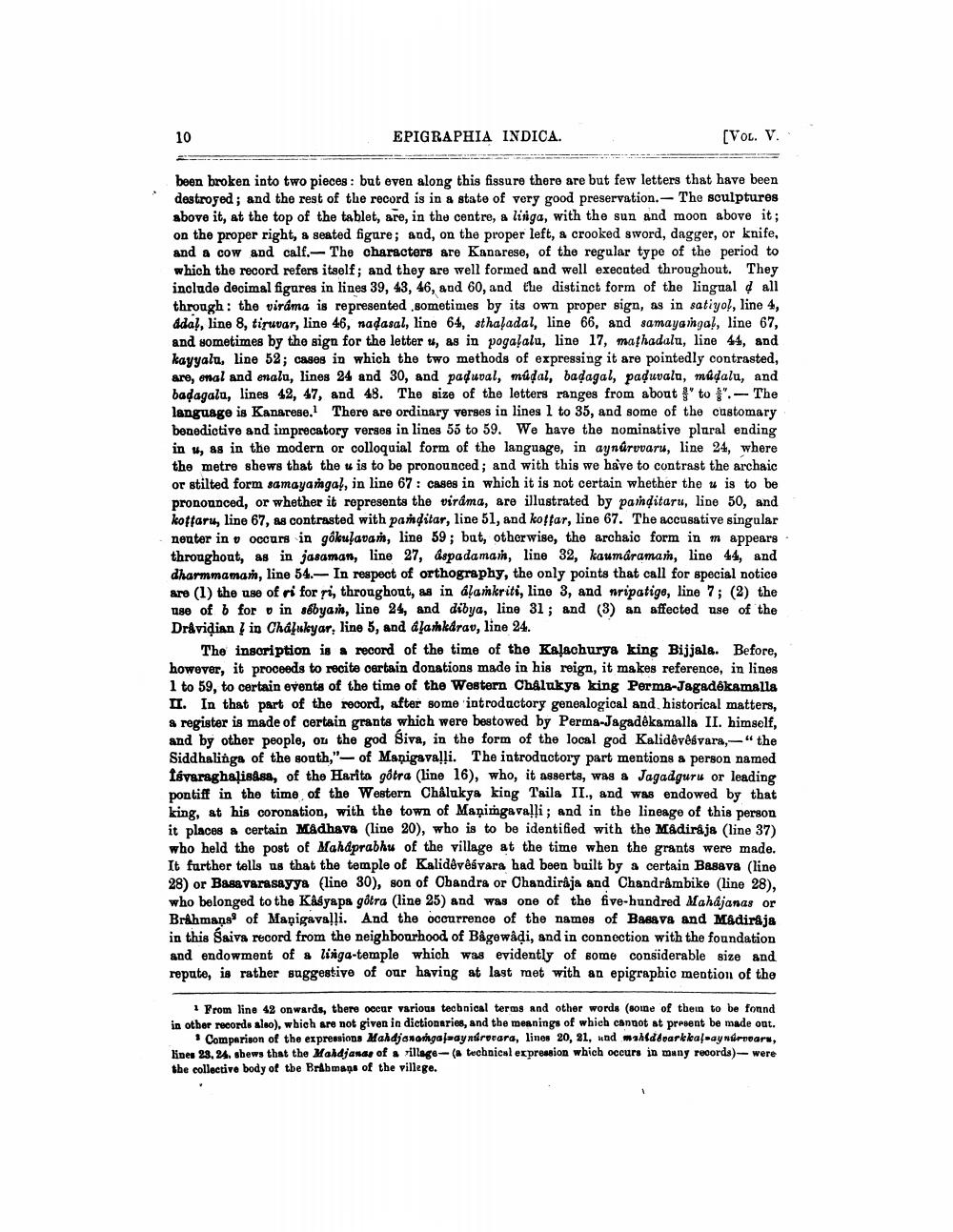________________
EPIGRAPHIA INDICA.
(VOL. V.
been broken into two pieces: but even along this fissure there are but few letters that have been destroyed; and the rest of the record is in a state of very good preservation. The sculptures above it, at the top of the tablet, are, in the centre, a linga, with the sun and moon above it; on the proper right, a seated figure; and, on the proper left, a crooked sword, dagger, or knife, and a cow and calf. The characters are Kanarese, of the regular type of the period to which the record refers itself; and they are well formed and well executed throughout. They include decimal figures in lines 39, 43, 46, and 60, and the distinct form of the lingual d all through: the virama is represented ,sometimes by its own proper sign, as in satiyol, line 4, adal, line 8, tiruvar, line 46, nadasal, line 64, sthaladal, line 66, and samayamgal, line 67, and sometimes by the sign for the letter #, as in pogalalu, line 17, mathadalu, line 44, and kayyalu, line 52; cases in which the two methods of expressing it are pointedly contrasted, are, onal and enala, lines 24 and 30, and padudal, müdal, badagal, paduvala, müdalu, and badagala, lines 42, 47, and 48. The size of the letters ranges from about " to ". - The language is Kanarese. There are ordinary verses in lines 1 to 35, and some of the customary benedictive and imprecatory verses in lines 55 to 59. We have the nominative plural ending in 4, as in the modern or colloquial form of the language, in aynúruvaru, line 24, where the metre shews that the u is to be pronounced ; and with this we have to contrast the archaic or stilted form samayanga!, in line 67 : cases in which it is not certain whether the u is to be pronounced, or whether it represents the viráma, are illustrated by panditaru, line 50, and koffaru, line 67, as contrasted with panditar, line 51, and koftar, line 67. The accusative singular neuter in o occurs in gôkulavan, line 59; bat, otherwise, the archaic form in m appears throughout, as in jasaman, line 27, úspadaman, line 32, kaumâraman, line 44, and dharmmaman, line 54.--In respect of orthography, the only points that call for special notice are (1) the use of ri for ri, throughout, as in dlankriti, line 3, and nripatige, line 7; (2) the use of b for o in sabyan, line 24, and dibya, line 31 ; and (3) an affected use of the Dravidian / in Chdfukyar, line 5, and alarkdrav, line 24.
The inscription is a record of the time of the Kalachurya king Bijjale. Before, however, it proceeds to recite certain donations made in his reign, it makes reference, in lines 1 to 59, to certain events of the time of the Western Chalukya king Perma-Jagadókamalla II. In that part of the record, after some introductory genealogical and historical matters, a register is made of certain grants which were bestowed by Perma-Jagadėkamalla II. himself, and by other people, on the god Siva, in the form of the local god Kalidēvēsvara, -"the Siddhalings of the south," - of Manigavalli. The introductory part mentions a person named Isvaraghalisisa, of the Harita gôtra (line 16), who, it asserts, was a Jagadguru or leading pontiff in the time of the Western Chålukya king Taila II., and was endowed by that king, at his coronation, with the town of Maņingavalli ; and in the lineage of this person it places a certain Madhava (line 20), who is to be identified with the Madiraja (line 37) who held the post of Maháprabhu of the village at the time when the grants were made. It further tells us that the temple of Kalidêvesvara had been built by a certain Basava (line 28) or Basavarasayya (line 30), son of Obandra or Chandiraja and Chandrâmbike (line 28), who belonged to the Kasyapa gôtra (line 25) and was one of the five-hundred Mahajanas or Brahmans of Mapigavalli. And the occurrence of the names of BabaVa and Madiraja in this Saiva record from the neighbourhood of Bågewadi, and in connection with the foundation and endowment of a linga-temple which was evidently of some considerable size and reputo, is rather suggestive of our having at last met with an epigraphic mention of the
From line 42 onwards, there occur various tecbnical terms and other words (some of them to be found in other records aloo), which are not given in dictionaries, and the meanings of which cannot at present be made out.
Comparison of the expressions Mahdjanangalaaynärprara, lines 20, 21, and mshidtparkkal-aynurpears, lines 23. 24. sbews that the Mahdjasan of a village-(a technical expression which occurs in many records) - were the collective body of the Bribmans of the villege.




